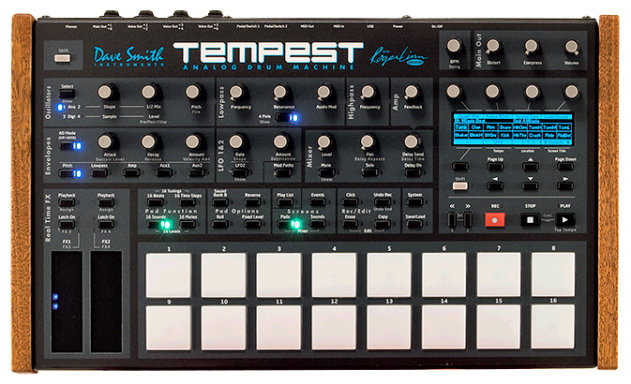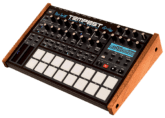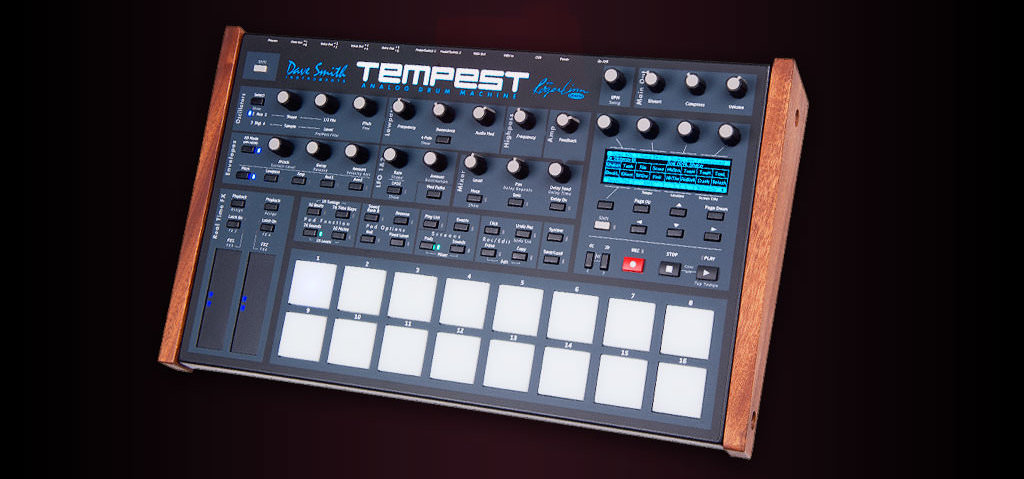Greg Scarth discovers whether the latest firmware revision delivers on this pricey analogue drum machine’s early promise.

The Tempest was always likely to be an interesting prospect. From the moment rumours began to circulate that Dave Smith and Roger Linn were to collaborate on a drum machine (provisionally named the BoomChik), we had high hopes. After all, both men have unimpeachable credentials in the field of electronic music.
Smith invented MIDI, designed Sequential Circuits‘ classic synths and is responsible for producing arguably the best range of analogue synths currently in production with the likes of the Mopho, the Tetra and the Prophet 08. Linn pioneered sample-based drum machines with his hugely successful LinnDrum series, then revolutionised sampling and drum sequencing with the Akai MPC60.
If you were looking to put together a dream team to create a new piece of drum hardware, you surely couldn’t do much better than Linn and Smith.
Work in progress
The Tempest was finally released last year, a short while before Attack launched. As a result, we didn’t review it when it first hit the market, but the recent release of Tempest OS version 1.2 gives us the perfect opportunity to assess this complex, nuanced product.
The unit’s launch itself has been the topic of some debate among potential buyers. Many felt – quite justifiably, in our opinion – that DSI were being impertinent expecting customers to pay a significant amount of money for a product which quite clearly wasn’t finished. Version 1.0 units functioned perfectly well, but many fundamental features were missing.
For a unit with a four-figure retail price, this was understandably a step too far for many buyers. To their credit, DSI offered a no-quibbles return policy, allowing buyers to test out the device in their studio, see if it delivered on its promises, then return it for a full refund if they chose.
OS 1.1 and 1.2 introduce many of the major features which users felt were lacking in the earlier software versions – MIDI control and sync; undo; odd time signatures; USB; a second bank of sounds, bringing the total to 32 per beat. So, is this really now the finished article?
The Tempest sound engine
 It would probably be naive to make major assumptions about the division of labour between Linn and Smith during the Tempest’s development, but one still can’t help getting excited by the combination of these two masters of audio hardware.
It would probably be naive to make major assumptions about the division of labour between Linn and Smith during the Tempest’s development, but one still can’t help getting excited by the combination of these two masters of audio hardware.
Thanks to the MPC60 and MPC3000, Linn’s credentials for designing sequencers are impeccable. Likewise, Smith’s mastery of analogue synthesis is evident from the likes of the Pro One and Prophet-5 right through to his current range of DCO-based modern classics.
First up, let’s take a closer look at the most important feature of the Tempest: its sound. Each of the Tempest’s voices is (loosely) based on the voice architecture employed in the Mopho, with a few changes to make it more suitable for drum synthesis.
Flicking through some of the preset sounds, it’s clear that the synth engine is versatile enough to create everything from booming, subby, 808-style kicks to lightning-fast percussive hits. But to use the Tempest as a preset machine would be to miss the point completely. If you want the hard work to be done for you, buy a sample pack. This is a device which demands that you get to grips with its phenomenally powerful sound engine.
Approaches to drum synthesis
At this point it’s worth considering how other analogue drum machines generate their sounds and how much versatility they offer. Roland’s classic analogue units – most notably the 606, 808 and 909 – are based around very simple electronic circuits.
(This isn’t to say that the circuits are unsophisticated – the self-damping bridged T-network oscillator used for the TR-808’s kick drum, for instance, is an ingenious use of a relatively uncommon circuit design which uses relatively few components, takes up very little circuit board space but helps define the distinctive sound of the 808’s famous kick.)
The trade-off for the simplicity of the circuits is that they aren’t particularly flexible. As standard, the 606 offers no adjustable sound parameters. The 808 allows the user to adjust very little other than tom tuning, decay on a couple of sounds and the famous snare drum ‘snappy’ control. The 909 raises the stakes slightly with kick drum and snare tuning, but in comparison to the expectations of modern users the analogue x0x drum machines are severely lacking.
Modern analogue options such as the Vermona DRM1, Jomox XBASE 888/999 and Acidlab Miami improve slightly on the traditional model, but each circuit is still based around a fixed architecture, intended for a single purpose. The clap circuit is always going to sound like a noise-based, percussive hit no matter what settings you dial in. That makes things slightly more immediate, but it also means you’re always operating within the restrictive parameters of a fixed framework.

05.48 PM
Thank you guys so much for this. I was actually planning on buying this today, and although it still sounds very enticing, you’ve given me the names of some other sequencers to look into. Good lookin’ out.
03.22 PM
great feature! could you perhaps do some passing notes on how to make pure analog drum sounds on it? i find myself using mainly sample drums, but using the analog osc’s for synth sounds.
i can’t wait for them to allow it to sequence other hardware. would also love to be able to set a multiple sounds to recieve midi notes from different channels.
04.30 PM
sorry guys but 5 stars for that machine i don´t know. maybe it sounds great but this thing is like a prototype you still can´t use all functions and the software in it has too many bugs. so i would wait or don´t buy it again.
09.12 PM
How old is this article? It isn’t much more than 808/909 prices?! It’s about a grand (in £’s) less!
01.02 PM
5 years on and Roger has acknowledged that its broken and is fixing it , after 5 years, class action anyone’s?